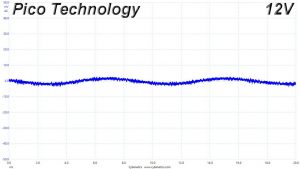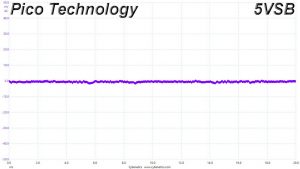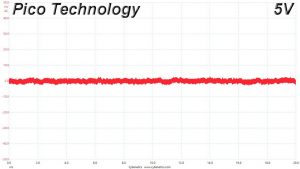To learn how we measure ripple, please click here.
The following table includes the ripple levels we measured on the RM850x’s rails. The limits, according to the ATX specification, are 120mV (+12V) and 50mV (5V, 3.3V, and 5VSB).
| Test | 12V | 5V | 3.3V | 5VSB | Pass/Fail |
| 10% Load | 1.6 mV | 3.8 mV | 2.8 mV | 1.9 mV | Pass |
| 20% Load | 8.0 mV | 5.0 mV | 4.8 mV | 3.5 mV | Pass |
| 30% Load | 6.6 mV | 4.3 mV | 3.2 mV | 2.4 mV | Pass |
| 40% Load | 5.9 mV | 5.7 mV | 5.3 mV | 3.7 mV | Pass |
| 50% Load | 5.7 mV | 5.8 mV | 5.0 mV | 3.6 mV | Pass |
| 60% Load | 6.2 mV | 5.5 mV | 4.4 mV | 3.4 mV | Pass |
| 70% Load | 6.2 mV | 8.1 mV | 5.7 mV | 5.6 mV | Pass |
| 80% Load | 6.3 mV | 6.4 mV | 5.9 mV | 4.1 mV | Pass |
| 90% Load | 7.0 mV | 7.2 mV | 6.9 mV | 5.1 mV | Pass |
| 100% Load | 7.2 mV | 8.5 mV | 7.2 mV | 5.7 mV | Pass |
| 110% Load | 7.3 mV | 8.4 mV | 6.4 mV | 5.7 mV | Pass |
| Crossload 1 | 7.0 mV | 7.3 mV | 6.5 mV | 3.3 mV | Pass |
| Crossload 2 | 6.9 mV | 6.1 mV | 4.0 mV | 4.2 mV | Pass |
The ripple suppression is amazing! The combination of a good design and the in-cable caps makes wonders.
Ripple Oscilloscope Screenshots
The following oscilloscope screenshots illustrate the AC ripple and noise registered on the main rails (+12V, 5V, 3.3V and 5VSB). The bigger the fluctuations on the screen, the bigger the ripple/noise. We set 0.01 V/Div (each vertical division/box equals 0.01V) as the standard for all measurements.
 KitGuru KitGuru.net – Tech News | Hardware News | Hardware Reviews | IOS | Mobile | Gaming | Graphics Cards
KitGuru KitGuru.net – Tech News | Hardware News | Hardware Reviews | IOS | Mobile | Gaming | Graphics Cards




















